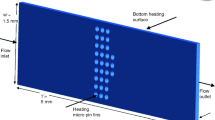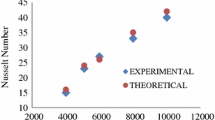Abstract
The present problem is devoted to establish the effect of orientation on thermohydraulic performance of a horizontal heat sink with vertical pin-fin-array under forced convective environment. The fins are embedded on the base-plate of the heat sink in inline and staggered manner. When air passes over the fin-arrays it convects the heat conducted from the solid base-plate to the fins’ surface. Both the experimental and numerical studies have been performed under the same geometric configurations of the test plate and an acceptable agreement in results is obtained. To examine the influence of the orientation angle (β) on system performance, the heat sink is rotated anticlockwise in a regular interval from 0° to 360° about a vertical axis passing through the centre of the sink. The study has been performed over a large number of incoming Reynolds numbers (Re = 8500 to 38500) to investigate the possibility to achieve an optimal angle of orientation when Nusselt number (Nu) is maximum. Test results show that thermal dissipation attains maximum value at β = 40° for the inline array and that for β = 120° in case of staggered array. For low Reynolds number values (Re = 8500), the system performance is found better at an angle 35° and 120° for inline and staggered arrangement respectively. However, with Re = 38500, the maximum system performance is achieved at an angle 10° and 240° for inline and staggered arrangement respectively.
Similar content being viewed by others
Abbreviations
- d h :
-
Channel hydraulic diameter (mm)
- D :
-
Pin diameter (mm)
- H :
-
Pin height (mm)
- H c :
-
Channel height (mm)
- k :
-
Thermal conductivity of fin material (W m−1K−1)
- k air :
-
Thermal conductivity of air (W m−1K−1)
- L :
-
Length of heated base plate (m)
- L Row :
-
Longitudinal pitch (mm)
- L Pitch :
-
Transverse pitch (mm)
- Nu :
-
Nusselt number
- P in :
-
Inlet pressure (Pa)
- P out :
-
Outlet pressure (Pa)
- ΔP :
-
Pressure drop across test section, Pin–Pout (Pa)
- q w :
-
Heat flux (W m−2)
- T in :
-
Inlet temperature (K)
- T out :
-
Outlet temperature (K)
- T w :
-
Average fin base temperature (K)
- u i :
-
Inlet air velocity (m/s)
- W c :
-
Channel width (mm)
- β :
-
Orientation angle
- η :
-
System performance
- μ :
-
Viscosity of air (kgm−1s−1)
- ρ :
-
Density of air (kgm−3)
References
M. Hatami, D. D. Ganji and M. Gorji-Bandpy, Experimental and numerical analysis of the optimized finned-tube heat exchanger for OM314 diesel exhaust exergy recovery, Energy Convers. Manage., 97 (2015) 26–41.
M. Hatami, D. D. Ganji and M. Gorji-Bandpy, Numerical study of finned type heat exchangers for ICEs exhaust waste heat recovery, Case Studies in Thermal Engineering, 4 (2014) 53–64.
M. Hatami, D. D. Ganji and M. Gorji-Bandpy, Optimization of finned-tube heat exchangers for diesel exhaust waste heat recovery using CFD and CCD techniques, International Communications in Heat and Mass Transfer, 57 (2014) 254–263.
J. Pandey, A. Husain, Md. Z. Ansari and N. Al-Azri, Performance analysis of cold plate heat sink with parallel channel and pin-fin, Materials Today Proceedings, 31st March (2021) https://doi.org/10.1016/j.matpr.2021.02.819.
W. Jin, J. Wu, N. Jia, J. Lei, W. Ji and G. Xie, Effect of shape and distribution of pin-fns on the flow and heat transfer characteristics in the rectangular cooling channel, Int. J. ThermScien., 161 (2021) 106758.
L. Ye, C. Liu, F. Zhang, J. Li and T. Zhou, Effect of the multiple rows of pin-fins on the cooling performance of cutback trailing-edge, Int. J. Heat Mass. Tranf., 170 (2021) 120992.
O. N. Sara, Performance analysis of rectangular ducts with staggered square pin fins, Energy Convers. Manage., 44 (2003) 1787–1803.
T. M. Jeng and S. C. Tzeng, Pressure drop and heat transfer of square pin-fin arrays in inline and staggered arrangement, Int J Heat Mass Tranf., 50 (2007) 2364–2375.
K. Yakut, N. Alemdaroglu, B. Sahin and C. Celik, Optimum design-parameters of a heat exchanger having hexagonal fins, Appl. Energ, 83 (2006) 82–98.
X. Yu, J. Feng, Q. Feng and Q. Wang, Development of a plate-pin fin heat sink and its performance comparisons with a plate fin heat sink, Appl. Therm. Eng., 25 (2005) 173–182.
K. S. Yang, W. H. Chu, I. Y. Chen and C. C. Wang, A comparative study of the airside performance of heat sinks having pin fin configurations, Int. J. Heat Mass. Trans., 50 (2007) 4661–4667.
P. Naphon and A. Sookkasem, Investigation on heat transfer characteristics of tapered cylinder pin fin heat sinks, Energy Convers. Manage., 48 (2007) 2671–2679.
I. Kotcioglu, G. Omeroglu and S. Caliskan. Thermal performance and pressure drop of different pin-fin geometries, Hittite J. Sci. Eng., 1(1) (2014) 13–20.
B. Sahin and A. Demir, Thermal performance analysis and optimum design parameters of heat exchanger having perforated pin fins, Energy Convers. Manage., 49 (2008) 1684–1695.
A. A. Damook, N. Kapur, J. L. Summers and H. M. Thompson, An experimental and computational investigation of thermal air flows through perforated pin heat sinks, Appl. Therm. Eng., 89 (2015) 365–376.
A. A. Damook, N. Kapur, J. L. Summers and H. M. Thompson, Computational design and optimisation of pin fin heat sinks with rectangular perforations, Appl. Therm. Eng., 105 (2016) 691–703.
S. B. Chin, J. J. Foo, Y. L. Lai and T. K. K. Yong, Forced convective heat transfer enhancement with perforated pin fins, Heat and Mass. Transf., 49(10) (2013) 1447–1458.
A. Maji, D. Bhanja and P. K. Patowari, Numerical investigation on heat transfer enhancement of heat sink using perforated pin fins with inline and staggered arrangement, Appl. Therm. Eng., 125 (2017) 596–616.
A. Maji, D. Bhanja and P. K. Patowari, Computational investigation and optimisation study on system performance of heat sink using perforated pin fins mounted at different angles, Progress in Computational Fluid Dynamics, An International Journal, 19(6) (2019) 381–400.
S. Sundar, G. Song, M. Z. Zahir, J. S. Jayakumar and S. J. Yook, Performance investigation of radial heat sink with circular base and perforated staggered fins, Int. J. Heat Mass. Tranf., 143 (2019) 118526.
Y. Rao, C. Wan and Y. Xu, An experimental study of pressure loss and heat transfer in the pin fin dimple channels with various dimple depths, Int. J. Heat Mass. Tranf., 55 (2012) 6723–6733.
Y. Rao, Y. Xu and C. Wa, An experimental and numerical study of flow and heat transfer in channels with pin fin-dimple and pin fin arrays, Exptherm. Fluid. Sci., 38 (2012) 237–247.
V. Choudhary, M. Kumar and A. K. Patil, Experimental investigation of enhanced performance of pin fin heat sink with wings, Appl. Therm. Eng., 155 (2019) 546–562.
P. K. Mandal, S. Sengupta, S. C. Rana and D. Bhanja, Thermal performance improvement of a fin-arrayed horizontal heat sink corroborating optimal orientation angle, Int. J. Innov. Tech. and Explor. Eng., 9 (2020) 1067–1075.
A. Durmus, A. Durmus and M. Esen, Investigation of heat transfer and pressure drop in a concentric heat exchanger with snail entrance, Appl. Therm. Eng., 22 (2002) 321–332.
R. T. Huang, W. J. Sheu and C. C. Wang, Orientation effect on natural convective performance of square pin fin heat sinks, Int. J. Heat Mass. Tranf., 51 (2008) 2368–2376.
A. A. Sertkaya, S. Bilir and S. Kargici, Experimental investigation of the effects of orientation angle on heat transfer performance of pin-finned surfaces in natural convection, Energy, 36 (2011) 1513–1517.
Author information
Authors and Affiliations
Corresponding author
Additional information
Pabitra Kumar Mandalis is a faculty of Dr. B. C. Roy Engineering College, Durgapur, West Bengal, India. He is holding the post of Assistant Professor in the Department of Mechanical Engineering. He is pursuing his Ph.D. in the Department of Mechanical Engineering, NIT -Durgapur, India. He did his B.E. (Mechanical) from Jalpaiguri Government Engineering College under University of North Bengal in the year of 2003. After that he did M. Tech. from I.I.T — Kharagpur in the Department of Aerospace Engineering in the year 2006. He is the life member of Indian Society for Heat and Mass Transfer (Regd.).
Sayantan Sengupta was born in 1987 in Pandua, a village in the district Hooghly, of West Bengal in India. Dr. Sayantan Sengupta is presently working as an Assistant Professor in the Department of Mechanical Engineering in NIT Durgapur, West Bengal. Before that, he was in Dr. B. C. Roy Engineering College, Durgapur, West Bengal, from September 2017 to October 2018 in the Department of Mechanical Engineering. He completed B. Tech. (Mechanical) from Jalpaiguri Government Engineering College in 2009. After that, he joined as an M. Tech. student in the Department of Mechanical Engineering of I.I.T-Kharagpur. He completed M. Tech. in 2011 and awarded a Ph.D. in 2017 from the same Institute. His expertise includes analytical fluid Mechanics, CFD, rotational flow, Tesla turbine, condensation, heat transfer augmentation, solar collector, and optimization techniques. To date, he has published 13 research articles in various SCI/SCIE indexed journals and a few papers in various other international journals and conferences. Sengupta has worked as a reviewer for different journals, viz. Journal of Fluid Mechanics, Physics of Fluids, European Journal of Mechanics-B/Fluids, Fluid Dynamics Research, Energy-Conversion and Management, International Journal of Mechanical Sciences, and Journal of Molecular Liquids.
Subhas Chandra Rana is a faculty in NIT - Durgapur, India. He is holding the post of Associate Prof. in the Department of Mechanical Engineering in the National Institute of Technology, Durgapur, India. He did his B. Tech. in the Mechanical Engineering Department from REC Durgapur in the year 1988 and M. Tech. from same institute in the year of 2002. His Ph.D. is from I.I.T- Madras in the year of 2016. His research interests include thermo-acoustic instability, CFD and heat transfer. He holds publications in reputed journals and conferences.
Dipankar Bhanja is a faculty in NIT - Silchar, India. He is holding the post of Assistant Professor, Grade-I in the Mechanical Engineering Department. He did his B. E. in Mechanical Engineering from Jalpaiguri Government Engineering College, India in the year of 2000 and M.E in Production Engineering from Jadavpur University in 2002. He did his Ph.D. Degree in Mechanical Engineering from Jadavpur University in 2014. He is the author of about 40 technical papers published in referred international journals and 35 papers in various other journals and conferences. Dr. Bhanja is the life member of Institute of Engineers. He is reviewer of various journals of repute.
Rights and permissions
About this article
Cite this article
Mandal, P.K., Sengupta, S., Rana, S.C. et al. Experimental and numerical investigation of square heat sink having staggered and inline pin fin arrays placed at different orientation. J Mech Sci Technol 35, 5187–5195 (2021). https://doi.org/10.1007/s12206-021-1036-8
Received:
Revised:
Accepted:
Published:
Issue Date:
DOI: https://doi.org/10.1007/s12206-021-1036-8




